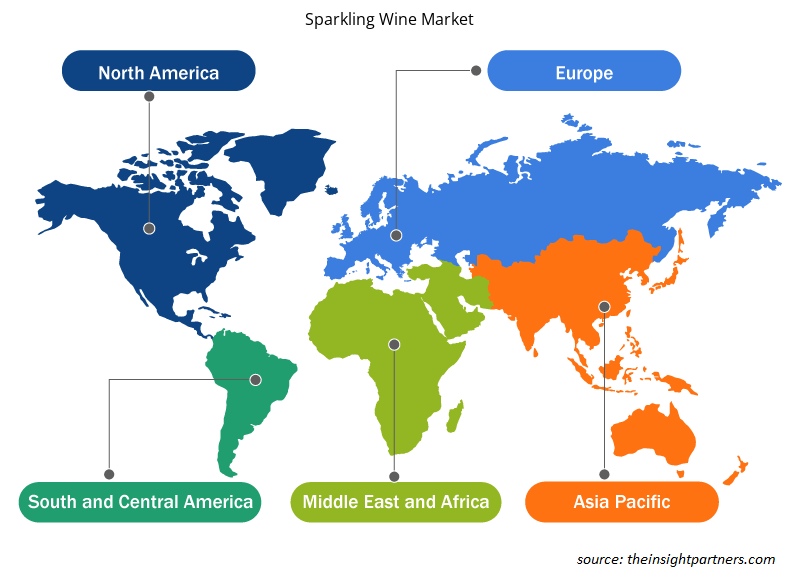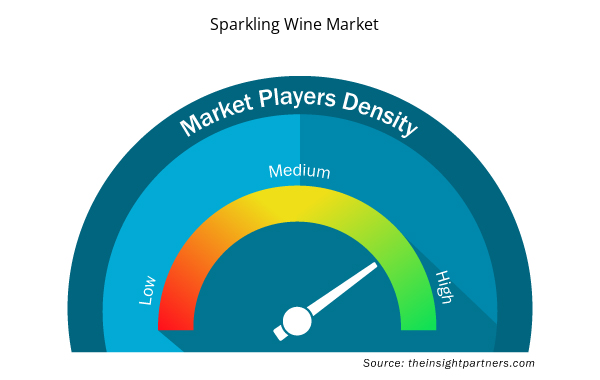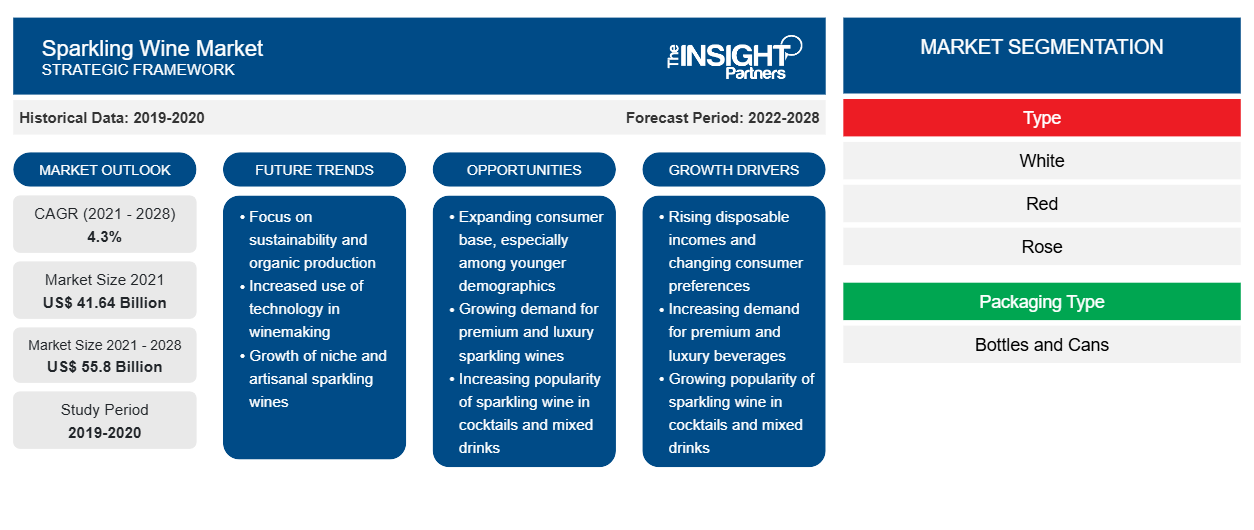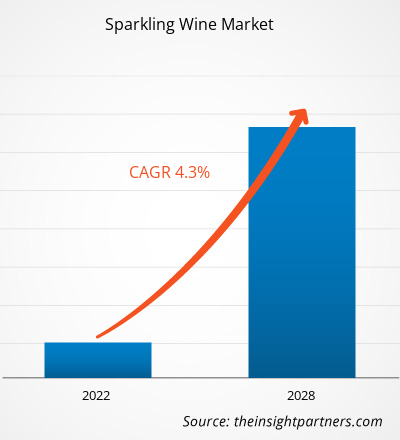El mercado del vino espumoso se valoró en 41.640 millones de dólares en 2021 y se proyecta que alcance los 55.800 millones de dólares en 2028; se espera que crezca a una CAGR del 4,3% entre 2021 y 2028.
El vino espumoso es una variante del vino con un alto contenido de dióxido de carbono, lo que le aporta más burbujas. El champán es uno de los tipos de vino espumoso más populares. Es el vino elaborado en la región de Champaña en Francia; sin embargo, muchos productores de vino espumoso en los EE. UU. usan este nombre para sus productos fabricados localmente.
En 2020, Europa representó la mayor parte del mercado de vino espumoso . La Unión Europea (UE) tiene la mayor concentración de productores de vino espumoso. Según el Instituto del Vino y la Vid, la UE representa entre el 70% y el 80%, en volumen, de la fabricación mundial de vino espumoso desde el año 2000. Según los expertos de la industria, Europa exporta un mayor volumen de vino espumoso que de vino tranquilo en los mercados internacionales. La región tiene una larga e ilustre historia de elaboración de vino. Los amantes del vino de todo el mundo prefieren el vino espumoso europeo debido a sus sabores, gustos y métodos de preparación únicos. Además, la creciente preferencia por las bebidas menos alcohólicas, la creciente influencia de las celebridades en los estilos de vida de las personas, la inclinación por los alimentos y bebidas preparados y la tradición de descorchar una botella de champán o vino espumoso durante las festividades y celebraciones, entre otros, justifican el dramático aumento de la demanda de esta categoría de vino. Europa tiene un mercado de vino espumoso altamente establecido, que consta de varios destiladores destacados y pequeños.
Los productores de vino espumoso se han visto afectados significativamente por la escasa disponibilidad de trabajadores durante la pandemia de COVID-19, lo que ha obstaculizado su capacidad de producción. Además, el cierre de los mercados mayoristas ha obligado a los fabricantes a depender principalmente de supermercados y distribuidores de comercio electrónico para vender sus productos de vino espumoso. A pesar de la pandemia, se ha producido un aumento en las ventas de vino rosado y espumoso.
Personalice este informe según sus necesidades
Obtendrá personalización en cualquier informe, sin cargo, incluidas partes de este informe o análisis a nivel de país, paquete de datos de Excel, así como también grandes ofertas y descuentos para empresas emergentes y universidades.
- Obtenga las principales tendencias clave del mercado de este informe.Esta muestra GRATUITA incluirá análisis de datos, desde tendencias del mercado hasta estimaciones y pronósticos.
Perspectivas del mercado
Aumento de la popularidad del vino espumoso
Los rápidos cambios socioeconómicos y la urbanización acelerada están impulsando la demanda de vino espumoso. Con el continuo aumento del nivel de vida y del poder adquisitivo, los clientes desean comprar artículos lujosos y de alta calidad. Además, sus hábitos alimentarios y preferencias gastronómicas cambian con estos cambios en el estilo de vida. Por lo tanto, la demanda de vino espumoso en fiestas, bodas y reuniones sociales está en aumento. Con la creciente preferencia por bebidas con bajo o ningún contenido de alcohol, la popularidad de este vino está aumentando entre los millennials, los adolescentes y las poblaciones trabajadoras, y entre los solteros y las personas que viven en albergues. Además, el uso generalizado de las redes sociales e Internet está afectando significativamente a todas las generaciones, mientras que el aumento del número de fiestas y eventos sociales está contribuyendo al aumento del consumo de vino espumoso a nivel mundial, principalmente en países desarrollados como Estados Unidos, Canadá, México, Alemania, Francia e Italia, impulsando así el crecimiento del mercado del vino espumoso.
Información sobre tipos
Según el tipo, el mercado del vino espumoso se segmenta en tinto, blanco y rosado. En 2020, el segmento blanco representó la mayor participación de mercado. El vino blanco se elabora con uvas Moscato Bianco de la región vinícola del Piamonte en Italia. Su producción se concentra principalmente en Alba y la provincia de Asti en el norte de Italia. Las burbujas son causadas por la fermentación natural, que puede ocurrir en la botella o en un tanque grande. La fermentación ocurre cuando se agrega azúcar al vino y la levadura actúa sobre el azúcar, generando dióxido de carbono. Las burbujas se forman en el vino como resultado del dióxido de carbono atrapado dentro de un ambiente cerrado.
Entre los actores clave del mercado del vino espumoso se encuentran Bacardi & Company Limited; Bronco Wine Co.; Casella; Constellation Brands, Inc.; Henkell Freixenet; Chandon; Schramsberg Wineyards; Pernod Ricard Winemakers; The Sparkling Wine Co.; Treasury Wine Estates Ltd; Bottega Spa; Campari Group; y Codorniu.
Perspectivas regionales del mercado del vino espumoso
Los analistas de Insight Partners explicaron en detalle las tendencias y los factores regionales que influyen en el mercado de vinos espumosos durante el período de pronóstico. Esta sección también analiza los segmentos y la geografía del mercado de vinos espumosos en América del Norte, Europa, Asia Pacífico, Oriente Medio y África, y América del Sur y Central.

- Obtenga datos regionales específicos para el mercado del vino espumoso
Alcance del informe sobre el mercado de vinos espumosos
| Atributo del informe | Detalles |
|---|---|
| Tamaño del mercado en 2021 | US$ 41.64 mil millones |
| Tamaño del mercado en 2028 | 55.800 millones de dólares estadounidenses |
| CAGR global (2021-2028) | 4,3% |
| Datos históricos | 2019-2020 |
| Período de pronóstico | 2022-2028 |
| Segmentos cubiertos | Por tipo
|
| Regiones y países cubiertos | América del norte
|
| Líderes del mercado y perfiles de empresas clave |
|
Densidad de actores del mercado de vinos espumosos: comprensión de su impacto en la dinámica empresarial
El mercado de vinos espumosos está creciendo rápidamente, impulsado por la creciente demanda de los usuarios finales debido a factores como la evolución de las preferencias de los consumidores, los avances tecnológicos y una mayor conciencia de los beneficios del producto. A medida que aumenta la demanda, las empresas amplían sus ofertas, innovan para satisfacer las necesidades de los consumidores y aprovechan las tendencias emergentes, lo que impulsa aún más el crecimiento del mercado.
La densidad de actores del mercado se refiere a la distribución de las empresas o firmas que operan dentro de un mercado o industria en particular. Indica cuántos competidores (actores del mercado) están presentes en un espacio de mercado determinado en relación con su tamaño o valor total de mercado.
Las principales empresas que operan en el mercado del vino espumoso son:
- Bacardi y Compañía Limitada
- Compañía de vinos Bronco.
- Casella
- Marcas Constellation, Inc.
- Henkell Freixenet
Descargo de responsabilidad : Las empresas enumeradas anteriormente no están clasificadas en ningún orden particular.

- Obtenga una descripción general de los principales actores clave del mercado del vino espumoso
Informe Destacado
- Tendencias progresivas de la industria en el mercado mundial de vinos espumosos para ayudar a los actores a desarrollar estrategias efectivas a largo plazo
- Estrategias de crecimiento empresarial adoptadas por empresas en mercados desarrollados y en desarrollo
- Análisis cuantitativo del mercado mundial de vinos espumosos de 2019 a 2028
- Estimación de la demanda de vino espumoso por parte de los consumidores
- Análisis PEST para ilustrar la eficacia de los compradores y proveedores que operan en la industria para predecir el crecimiento del mercado
- Avances recientes para comprender el escenario competitivo del mercado y la demanda de vino espumoso
- Tendencias y perspectivas del mercado junto con los factores que impulsan y restringen el crecimiento del mercado del vino espumoso
- Comprensión de las estrategias que sustentan el interés comercial en el mercado, ayudando así en el proceso de toma de decisiones de los actores del mercado.
- Tamaño del mercado de vinos espumosos en varios nodos del mercado
- Descripción detallada y segmentación del mercado mundial de vinos espumosos, así como su dinámica industrial
- Tamaño del mercado del vino espumoso en varias regiones con oportunidades de crecimiento prometedoras
Mercado de vinos espumosos por tipo
- Blanco
- Rojo
- Rosa
Mercado de vinos espumosos por tipo de envase
- Botellas
- Latas
Mercado de vinos espumosos por canal de distribución
- Supermercados e Hipermercados
- Tiendas especializadas
- Venta minorista en línea
- Otros
Perfiles de empresas
- Bacardi y Compañía Limitada
- Compañía de vinos Bronco.
- Casella
- Marcas Constellation, Inc.
- Henkell Freixenet
- Viñedos de Schramsberg
- Enólogos de Pernod Ricard
- La Compañía de Vinos Espumosos.
- Fincas vinícolas del Tesoro Ltd.
- Chandon
- Análisis histórico (2 años), año base, pronóstico (7 años) con CAGR
- Análisis PEST y FODA
- Tamaño del mercado Valor/volumen: global, regional, nacional
- Industria y panorama competitivo
- Conjunto de datos de Excel



Report Coverage
Revenue forecast, Company Analysis, Industry landscape, Growth factors, and Trends

Segment Covered
This text is related
to segments covered.

Regional Scope
North America, Europe, Asia Pacific, Middle East & Africa, South & Central America

Country Scope
This text is related
to country scope.
Preguntas frecuentes
Cans segment accounted for a minor share in 2020. Bottles re the most preferred type of packaging among sparkling wine consumers and manufacturers alike. However, cans can be used for single-serve and the recyclability has interested the eco-friendly consumers. Moreover, the young population that do not wish to buy an entire bottle are another target group expected to aid the growth of the cans segment over the forecast period.
Asia Pacific region accounts for a significant share of the global population and the rising disposable incomes and urbanization have contributed to the growth of the sparkling wine market in the region. The per capita consumption of wine is significantly low in the countries of Asia Pacific with respect to the western countries and this represents a significant potential for sparkling wine manufacturers. Moreover, interest in different varieties of sparkling wine from the countries such as China and India have also grown in the recent years.
Supermarkets and hypermarkets accounted for the largest share of the sparkling wine market in terms of distribution channel. The high footfall in supermarkets and hypermarkets makes it easier for sparkling wine manufacturers to target a wider customer base. The sparkling wine manufacturers mainly focus on selling sparkling wine via supermarkets and hypermarkets as they can enjoy the benefits of nationwide or area wide coverage and hence, generate a larger volume of sales.
Rose segment has been witnessing increasing popularity in recent years across the globe. Its distinct taste and color have increased its appeal among the population. Although it is a smaller category with respect to white, the segment has been registering significant growth in recent years.
The major players operating in the global sparkling wine market are Bacardi & Company Limited; Bronco Wine Co.; Casella; Constellation Brands, Inc.; Henkell Freixenet; Chandon; Schramsberg Wineyards; Pernod Ricard Winemakers; The Sparkling Wine Co.; Treasury Wine Estates Ltd; Bottega Spa; Campari Group; and Codorniu among many others.
Sparkling wines are widely consumed across the globe, especially in western countries. They are available in bottles and cans, although they are mostly purchased in bottles.
Based, on type, the sparkling wine market is segmented into white, red, and rose. Packaging type segmentation includes bottles, and cans. Based on distribution channel, the global sparkling wine market is segmented into supermarkets and hypermarkets, specialty stores, online retial, and others.
Trends and growth analysis reports related to Food and Beverages : READ MORE..
The List of Companies - Sparkling Wine Market
- Bacardi and Company Limited
- Bronco Wine Co.
- Casella
- Constellation Brands, Inc.
- Henkell Freixenet
- Schramsberg Wineyards
- Pernod Ricard Winemakers
- The Sparkling Wine Co.
- Treasury Wine Estates Ltd
- Chandon
The Insight Partners performs research in 4 major stages: Data Collection & Secondary Research, Primary Research, Data Analysis and Data Triangulation & Final Review.
- Data Collection and Secondary Research:
As a market research and consulting firm operating from a decade, we have published and advised several client across the globe. First step for any study will start with an assessment of currently available data and insights from existing reports. Further, historical and current market information is collected from Investor Presentations, Annual Reports, SEC Filings, etc., and other information related to company’s performance and market positioning are gathered from Paid Databases (Factiva, Hoovers, and Reuters) and various other publications available in public domain.
Several associations trade associates, technical forums, institutes, societies and organization are accessed to gain technical as well as market related insights through their publications such as research papers, blogs and press releases related to the studies are referred to get cues about the market. Further, white papers, journals, magazines, and other news articles published in last 3 years are scrutinized and analyzed to understand the current market trends.
- Primary Research:
The primarily interview analysis comprise of data obtained from industry participants interview and answers to survey questions gathered by in-house primary team.
For primary research, interviews are conducted with industry experts/CEOs/Marketing Managers/VPs/Subject Matter Experts from both demand and supply side to get a 360-degree view of the market. The primary team conducts several interviews based on the complexity of the markets to understand the various market trends and dynamics which makes research more credible and precise.
A typical research interview fulfils the following functions:
- Provides first-hand information on the market size, market trends, growth trends, competitive landscape, and outlook
- Validates and strengthens in-house secondary research findings
- Develops the analysis team’s expertise and market understanding
Primary research involves email interactions and telephone interviews for each market, category, segment, and sub-segment across geographies. The participants who typically take part in such a process include, but are not limited to:
- Industry participants: VPs, business development managers, market intelligence managers and national sales managers
- Outside experts: Valuation experts, research analysts and key opinion leaders specializing in the electronics and semiconductor industry.
Below is the breakup of our primary respondents by company, designation, and region:

Once we receive the confirmation from primary research sources or primary respondents, we finalize the base year market estimation and forecast the data as per the macroeconomic and microeconomic factors assessed during data collection.
- Data Analysis:
Once data is validated through both secondary as well as primary respondents, we finalize the market estimations by hypothesis formulation and factor analysis at regional and country level.
- Macro-Economic Factor Analysis:
We analyse macroeconomic indicators such the gross domestic product (GDP), increase in the demand for goods and services across industries, technological advancement, regional economic growth, governmental policies, the influence of COVID-19, PEST analysis, and other aspects. This analysis aids in setting benchmarks for various nations/regions and approximating market splits. Additionally, the general trend of the aforementioned components aid in determining the market's development possibilities.
- Country Level Data:
Various factors that are especially aligned to the country are taken into account to determine the market size for a certain area and country, including the presence of vendors, such as headquarters and offices, the country's GDP, demand patterns, and industry growth. To comprehend the market dynamics for the nation, a number of growth variables, inhibitors, application areas, and current market trends are researched. The aforementioned elements aid in determining the country's overall market's growth potential.
- Company Profile:
The “Table of Contents” is formulated by listing and analyzing more than 25 - 30 companies operating in the market ecosystem across geographies. However, we profile only 10 companies as a standard practice in our syndicate reports. These 10 companies comprise leading, emerging, and regional players. Nonetheless, our analysis is not restricted to the 10 listed companies, we also analyze other companies present in the market to develop a holistic view and understand the prevailing trends. The “Company Profiles” section in the report covers key facts, business description, products & services, financial information, SWOT analysis, and key developments. The financial information presented is extracted from the annual reports and official documents of the publicly listed companies. Upon collecting the information for the sections of respective companies, we verify them via various primary sources and then compile the data in respective company profiles. The company level information helps us in deriving the base number as well as in forecasting the market size.
- Developing Base Number:
Aggregation of sales statistics (2020-2022) and macro-economic factor, and other secondary and primary research insights are utilized to arrive at base number and related market shares for 2022. The data gaps are identified in this step and relevant market data is analyzed, collected from paid primary interviews or databases. On finalizing the base year market size, forecasts are developed on the basis of macro-economic, industry and market growth factors and company level analysis.
- Data Triangulation and Final Review:
The market findings and base year market size calculations are validated from supply as well as demand side. Demand side validations are based on macro-economic factor analysis and benchmarks for respective regions and countries. In case of supply side validations, revenues of major companies are estimated (in case not available) based on industry benchmark, approximate number of employees, product portfolio, and primary interviews revenues are gathered. Further revenue from target product/service segment is assessed to avoid overshooting of market statistics. In case of heavy deviations between supply and demand side values, all thes steps are repeated to achieve synchronization.
We follow an iterative model, wherein we share our research findings with Subject Matter Experts (SME’s) and Key Opinion Leaders (KOLs) until consensus view of the market is not formulated – this model negates any drastic deviation in the opinions of experts. Only validated and universally acceptable research findings are quoted in our reports.
We have important check points that we use to validate our research findings – which we call – data triangulation, where we validate the information, we generate from secondary sources with primary interviews and then we re-validate with our internal data bases and Subject matter experts. This comprehensive model enables us to deliver high quality, reliable data in shortest possible time.


 Obtenga una muestra gratuita de este informe
Obtenga una muestra gratuita de este informe